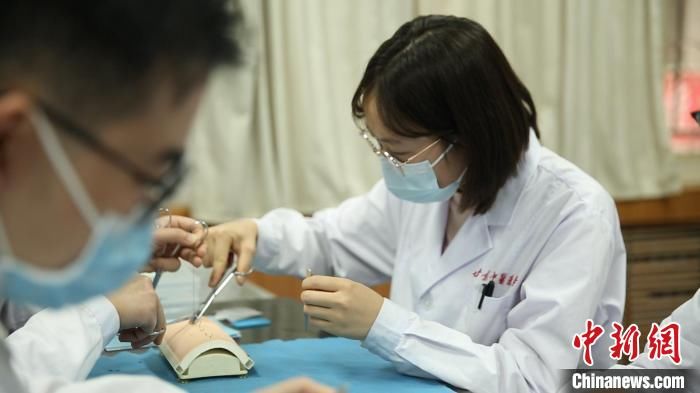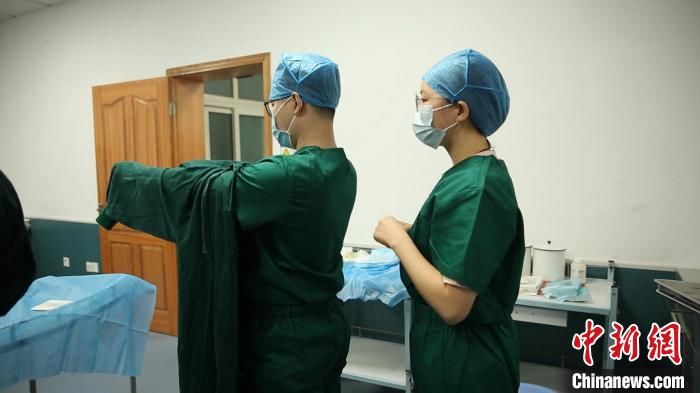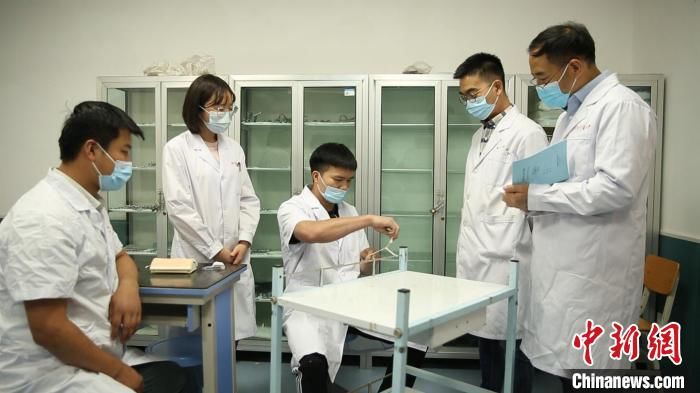
Gansu University of Traditional Chinese Medicine innovates surgical teaching methods. The picture shows students performing debridement and suturing exercises. (Data map) Photo courtesy of the First Clinical Medical College of Gansu University of Traditional Chinese Medicine
Chinanews.com Lanzhou, February 24 (Reporter Yang Na) “Students are always sloppy and careless when they participate in clinical practice in the early stage. They forget to wear tape when changing dressings, and forget to ask medical history when filling out cases.” During more than 10 years of teaching career, Li Junliang, deputy chief physician of the General Surgery Department of Gansu Provincial People’s Hospital, was quite troubled by this problem.
As the secretary of the Department of Surgery, the First Clinical Medical College of Gansu University of Traditional Chinese Medicine, Li Junliang recently discovered that by asking students to create a list, each step of the clinical operation is listed in the form of a list. By operating according to the list, the problems of being careless and careless have been greatly improved, and the rate of clinical operation errors has been greatly reduced.

The picture shows students practicing putting on and taking off surgical gowns. (Data map) Photo courtesy of the First Clinical Medical College of Gansu University of Traditional Chinese Medicine
The above-mentioned establishment of a graded teaching model through the formulation of a checklist system (Checklist system) is a microcosm of the innovative surgical teaching method of Gansu University of Traditional Chinese Medicine. In 2019, Gansu Provincial People’s Hospital and Gansu University of Traditional Chinese Medicine jointly established the First Clinical Medical College, and the Department of Surgery will undertake the teaching of surgery courses.
It is understood that this is an important measure for Gansu to deepen the coordinated development of medical education, promote the reform of medical education, and improve the quality of modern medical personnel training in the province.
Li Junliang said that surgery is a main medical course with distinctive practical characteristics, including two parts: theoretical teaching and clinical practice. Before learning surgery, most medical students have the same understanding as hands-on operation, so they focus on practical operation and ignore theory. After learning to a certain extent, they will have insufficient stamina due to lack of theory; some students concentrate on learning theory and do not have a good opportunity for practical operation. , and ultimately not suitable for medical career development.
To this end, Professor Cai Hui, Director of the Department of Surgery, Gansu University of Traditional Chinese Medicine, led the team, combined with the questionnaires and interviews of students and teachers, to sort out the pain points of surgery teaching and reshape the teaching content of surgery. Medical colleges and hospitals jointly build and run schools, taking into account both theoretical and practical teaching.

The picture shows the students in the surgical knot test. (Data map) Photo courtesy of the First Clinical Medical College of Gansu University of Traditional Chinese Medicine
Among them, to force input by output is an important reform content. “For example, learning a foreign language requires the ability to speak, read, write, and read. When you are good at writing and speaking, and you continue to export knowledge, your reading and writing skills will naturally improve.” Li Junliang said that after the reform, Feynman will be used to teach surgery as a teaching method. Law is the theoretical basis, and students are encouraged to take the initiative to output knowledge, emotion and skills, so as to achieve self-development.
Li Junliang said that students are encouraged to learn by making mind maps before class, and students are encouraged to communicate with each other in groups. Through real case guidance, classroom interaction, and optional homework after class, students are promoted to theoretical output.
Through the positive guidance of teachers, all students take the initiative to mine ideological and political elements to achieve educational purposes. Promote students’ emotional output; create a graded teaching model by formulating a checklist system, and compile PBL teaching materials that conform to students’ cognitive characteristics (PBL refers to project-based teaching, which is a set of problem-oriented teaching designed for learning situations. method), establish a virtual simulation operating system, and promote students to take the initiative to output skills.
“Students will gain a sense of achievement in the process of output. When encountering problems, they are forced to automatically find the answer consciously. The effect is far better than the teacher’s cramming teaching.” Li Junliang said frankly that the reform of teaching methods has given students greater The space and stage gain self-growth and enhance the inner drive of students’ learning.
Before studying the course of surgery, Song Wenqi, a student of Gansu University of Traditional Chinese Medicine, always believed that a medical student who needs to study for 5 years in the undergraduate course, the study life is a teaching model of “teacher lectures, students memorize, and exam memorization”. In the surgery class, he and his classmates are the protagonists of the class. They find the problem and then find the solution with the help of the teacher, which increases their interest in learning.
“Many students can’t really understand the knowledge when they recite it mechanically, let alone use it flexibly.” After enhancing his learning initiative, Song Wenqi felt that the theoretical knowledge that was boring and difficult to remember in the past is much easier to remember.
With solid theoretical accumulation, the teacher was able to pull out the cocoon in the face of a complex and chaotic case, and finally diagnosed it as appendicitis. This also made Song Wenqi, who had thought of surgery since the first mention of surgery, realize that without the support of theory, the surgeon could not even stretch out his hands to hold the scalpel.
The new semester is about to start. Song Wenqi has finished his study of surgery. He has benefited a lot from the learning method with half the effort and is ready to apply it in the study of other disciplines.
Li Junliang is also thinking about how to enhance the communication skills between students and patients. “As a doctor in the future, you must master skills in communicating with patients and correct your posture in order to achieve good communication with patients, so as to achieve ideal results in disease treatment.”(End)